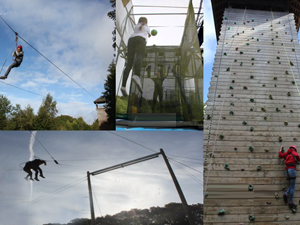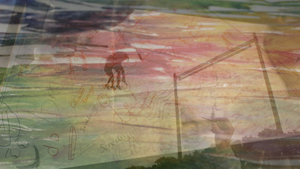Overview
Life Support was a collaborative project with nine young people and workers from Forsythia Youth, two academics (Emma Renold, Cardiff University and Gabrielle Ivinson, Manchester Metropolitan University), and two artists (Heloise Godfrey-Talbot and Rowan Talbot). It was part-funded by the ESRC/AHRC Productive Margins Programme as a pilot project with seed corn funding.
It continues our long-term collaborations with Forsythia Youth and creative engagement projects with young people in the south Wales valleys.
PARTicipatory Process: runaway methodologies
 We co-produced a series of activities and workshops with artists, youth workers and young people over 10 months. We have theorised this process, as ‘Runaway Methodologies’.
We co-produced a series of activities and workshops with artists, youth workers and young people over 10 months. We have theorised this process, as ‘Runaway Methodologies’.
Our method can be captured by three steps:
- Event: setting up an event; participating alongside others while attuning to the micro intensities of moments within the event;
- Run(a)way: enabling initial ideas that emerge
- Arts-based workshops: providing arts materials and techniques to enable initial ideas to be expressed through other media, and so by reframed ideas as matter they can become objects/artefacts/’darta’ (Renold 2018) for further reflection and wider public communication and engagement.
The basis of the approach is to capture ideas in the making and enable them to stay alive and active by offering a pallet of materials to enable expression. We describe the steps in more detail as follows:
1 Events
We set up events sometimes based on what participants ask us to set up, such as the physical activities that this group choose to undertake during a residential adventure weekend (Giant Swing, Zip wire, Aero Ball and Rock Climbing).
Sometimes we set up events around art materials such as the workshops we orchestrated between the physical activities on the residential weekend.
During the residential at an Activity Centre the zip wire activity fulfilled the groups’ requirements for a challenging, physical activity that literally took them and us to an edge.
2 Runaway
After the activity a long piece of paper (runway) was rolled out on the art-room floor and everyone wrote or drew something to ‘land’ expressions of what it had felt as part of the activity. Some wrote words or phrases to capture the emptions (affects) that had been experienced after we had climbed a high tower, put ourselves into a harness and launched our bodies over a precipice.
Such events enable us to relive an emotion such as fear (in a safe environment), to feel it, and as part of that feeling to evoke past fears. The past and present feelings are experienced bodily and bodies might reconnect with patterns of feelings that have been created through prior evoked experiences (of fear).
A runway is both a landing platform, where ideas are landed, and a take-off platform, where new ideas take off. We have found that the size and width of the paper, the way it can be rolled out before everyone, so that everyone can gather round it and the way it can be rolled up afterwards to store ideas, is particularly effective.
The runway is the first invitation to communicate through a medium other than the spoken word. So we move from speech to depiction (word and drawings).
3 Arts-based workshops
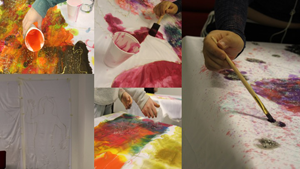 In this step we move from speech and early depictions on the Runway to art media. By offering a pallet of materials and tools such as a piece of silk, a blank sheet, paints, paper, straws, glue, glitter, string, nails, hammer, tweezers, sticky tape, coloured string and pieces of wood, we try to enable expression in different forms or modalities that go beyond the limitations of the spoken word.
In this step we move from speech and early depictions on the Runway to art media. By offering a pallet of materials and tools such as a piece of silk, a blank sheet, paints, paper, straws, glue, glitter, string, nails, hammer, tweezers, sticky tape, coloured string and pieces of wood, we try to enable expression in different forms or modalities that go beyond the limitations of the spoken word.
We think very carefully about what to offer, in what kind of space, and using what kind of words or instructions. At this stage we usually work closely with an artist to co-produce the workshop’s materials and space.
We try to enable ‘anything’ to happen while remaining very aware that, for example, the space, the shape of a room, the amount of light, the number of tables or pieces of silk, as well as the size of the paint-brushes, all become part of the material assemblage that shapes what might emerge.
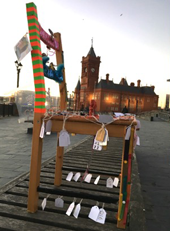 The Da(r)tafacts: ‘Chairing our feelings’ and ‘Body Silks’
The Da(r)tafacts: ‘Chairing our feelings’ and ‘Body Silks’
The dartafacts produced in these workshops, such as the Chair and Silks have travelled to many venues.
The dartafacts have the power to move and represent the young people in a policy making events, community festivals and forums and at academic conferences and workshops (see below).
The film: Life Support
Life Support is a film dedicated to the young people and staff at the Forsythia Youth project, North Merthyr. The young people explained the film as follows:
It draws upon our experiences from an arts-based adventure project that helped us explore what was troubling us. We wanted others, especially those in power, to feel how we feel. We learned that resilience is more than us. It is in people and place, in friends and family, and most of all, in Forsythia. We started with anger and we became so much more.
The young people created a poem to express their experience:
We are fear
We are anger
We are pride
We are joy
We are silk
We are human
We are equal
We are one
We are Forsythia YOUTH!
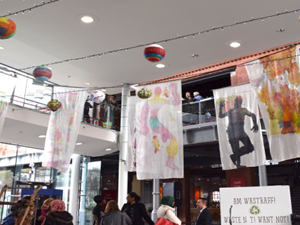 The film (along with body-silks) was premiered at the Wales Millennium Centre, Cardiff, at the International Women’s Day Festival on 12 March 2017, to an audience of 300. The film continues to be shown at community venues and academic conferences worldwide.
The film (along with body-silks) was premiered at the Wales Millennium Centre, Cardiff, at the International Women’s Day Festival on 12 March 2017, to an audience of 300. The film continues to be shown at community venues and academic conferences worldwide.
Manchester Metropolitan University awarded an impact accelerator grant to Professor Gabrielle Ivinson and Dr Geoff Bright in 2018. Life Support will also be shown at events in six industrialised coalfield communities in the north of England, and South Wales ex-mining valleys, in events co-hosted with community partners Unite Community and the Co-operative College
Life Support and creative youth activism
The film became part of the young people’s campaign against the closure of the Forsythia Youth Facility when Communities First ends.
On 14th February 2017, the Cabinet Secretary for Communities and Children announced that the Communities First programme would be phased out by March 2018. Although the Forsythia Youth Facility was established long before Communities First in response to the needs of young people on a housing estate, the youth workers were funded through Communities First money.
On hearing the news of possibly and imminent closures Forsythia Youth Facility the young people mounted a twitter campaign, and a change.org petition (which included over 500 statements of support). The film Life Support became part of their protest. The young people took their case to the Welsh Government.
Texts accompanying the film sequences in Life Support were written by young people themselves:
This place is my life, it means the world to me
Forsythia is the heart-beat of Merthyr’s young people
Government cuts are slowly strangling valleys communities
stop stop stop they need to listen enough is enough
The following is a sample of messages posted on the young people’s campaign site and listed at the end of the film before the credits:
We dedicate this film to all the children, young people, staff and visitors who keep the heartbeat of Forsythia Youth pumping
If this place closes, the lifeline that these young people need so much will be lost forever
If this centre closes it will be an act of neglect
It’s a second home to many young people
This youth centre gives children memories to last a life-time
This project saves lives
They accepted me for who i am It offers the most life changing experiences and trips that deeply inspire us as young people!
I for sure look up to each and everyone of the youth workers at forsythia youth as role models for me in the future
One of our favourite childhood places so many opportunities and experiences
This place has taught me all the values of life and so much more it’s just amazing
Without this youth I’d be so lost
Been involved with forsythia for around 8 years now, and when I say it changed my life I 100% mean it!
Without this project and the fabulous staff I would honestly not be where I am today and closing this project would prevent generations from accessing the same life changing opportunities that I got!
Closing this youth will be closing a family! There’s bonds so strong within that’s so special
Forsythia Youth remains open yet with reduced staff and with the loss of one of the pivotal youth leaders who had sourced the money and resources to open the Facility two decades previously.
Watch the film Life Support on Vimeo »
Life Support, influencing policy and practice
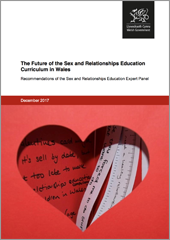 Professor Ivinson was Invited to present evidence at the Welsh Government’s Expert Panel to inform the development of the new Sex and Relationships Education Curriculum in Wales on 24 July 2017
Professor Ivinson was Invited to present evidence at the Welsh Government’s Expert Panel to inform the development of the new Sex and Relationships Education Curriculum in Wales on 24 July 2017
The presentation title is: Exploring Creative and Cross-Curricular approaches for holistic and inclusive Sexuality and Relationships Education (HISRE) Re-Imagining risk, resilience and the ACES agenda for future SRE with youth-led arts-based pedagogies
A substantial section in the final report submitted to Welsh Government, included the affordances of creative pedagogy for effective SRE. One of the case studies included examples of ‘Body Mapping’ from the Life Support project (Productive Margins).
This method has been developed in the project: EveryBODY Matters: feeling difference and diversity through movement, sound and image (forthcoming 2018, www.agenda.wales).
This work also went on to inform Ivinson’s research for the Youth Justice SEND: Securing better Outcomes for Children and Young People with SEND in the Youth Justice System, funded by Department for Education and Achievement for All, Part 2 (2017-2018) (PI Peter Hick, Manchester Metropolitan University)
Associated academic keynotes and workshops
Professor Gabrielle Ivinson, Professor Emma Renold, Jên Angharad. (2017) Mobilising Run-a-way Methodologies for Life Support
Date and location: 10th July-14th July 2017, Summer Institute in Qualitative Research: Putting Theory to Work, Manchester Metropolitan University.
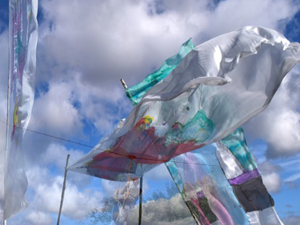 These workshops and keynote, and the video that was made, has notably increased the profile of the research-engagement methodologies we are creating, as a direct outcome of the projects and processes within the Productive Margins Programme.
These workshops and keynote, and the video that was made, has notably increased the profile of the research-engagement methodologies we are creating, as a direct outcome of the projects and processes within the Productive Margins Programme.
Vital here is that they enable us to continue to work and collaborate with our artists, whose time and preparation is paid for, and needs to be, as self-employed and no longer funded inside the PM programme. This keynote featured the making and final film, Life Support.
Watch the performance on Youtube »
Professor Gabrielle Ivinson, Professor Emma Renold, Jên Angharad (2017) Moving with the not-yet: choreographing the political with young people in space, place and time, Generative Feminism(s): working across/ within/ through borders
Date and location: 21st-23rd June 2017, Gender and Education Association Bi-Annual Conference, Middlesex University
Watch some of our performance on Vimeo »
Key contacts
- Gabrielle Ivinson
Email: Ivinson@mmu.ac.uk - Emma Renold
Email: renold@cf.ac.uk

